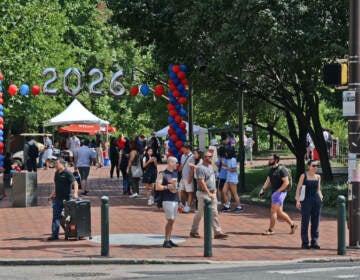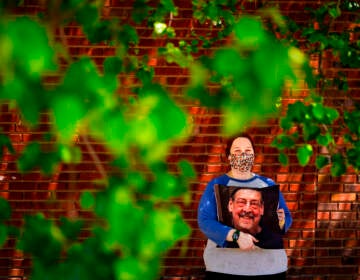South Jersey filmmaker Brian Holcomb, 46, died before finishing his greatest work
Brian Holcomb spent two decades making his greatest film. After his death from COVID-19, three childhood friends from Atco want to help him finish it.
Listen 2:33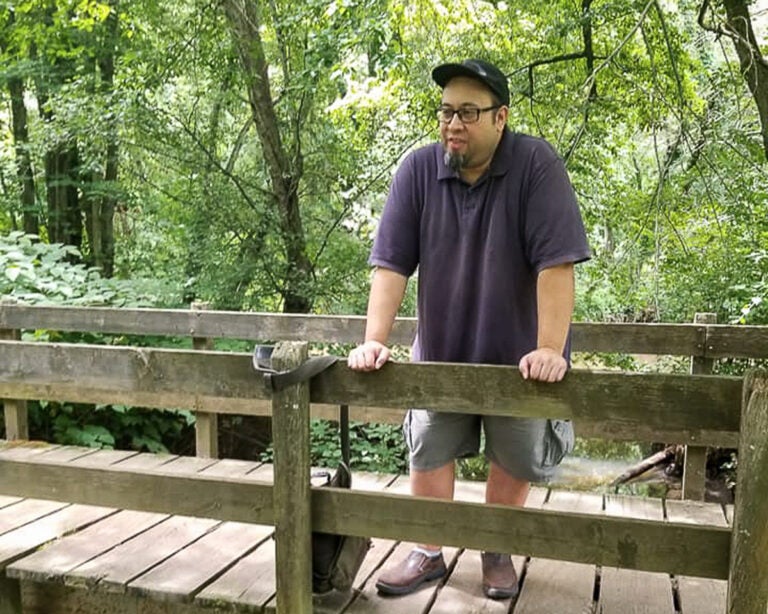
Brian Holcomb (Courtesy of Casie Bodine)
This story is part of WHYY’s series “COVID-19: Remembering lives we’ve lost” about the everyday people the Philadelphia region has lost to the coronavirus pandemic, the lives they lived, and what they meant to their families, friends and communities.
When he was in fourth grade, John Boggi met a movie-mad kid named Brian Holcomb.
“In fourth grade, he was talking about Orson Welles,” said Boggi, of Atco, New Jersey. “Even at an early age, he was a film fanatic.”
“He was like a black hole: He sucked in all the information he could find, and he never got rid of it,” said another childhood friend from Atco, Dennis DiClaudio. “He remembered everything.”
Film was Holcomb’s lifelong passion: Watching them, writing about them, and making them. He made a string of short, low-budget movies, but his greatest work, perhaps, would have been “Deadwood Falls,” a sprawling, fragmentary feature film about a small town beset by an unknowable evil.
Holcomb worked on it for most of his adult life, but never finished it. He contracted COVID-19 in March and died at the age of 46 on April 11.
The film obsessed him for 22 years, a length of time that surprised even DiClaudio.
“It sounds ridiculous to say that out loud, but I’m almost certain,” he said. DiClaudio was there at the beginning and spent decades helping Holcomb realize his vision for the film.
DiClaudio and Holcomb studied film together at Temple University, but neither graduated from the program. DiClaudio moved into writing. Holcomb enrolled at the University of the Arts, but later dropped out.
“Listening to people telling him what to do was not his strong suit,” said DiClaudio.
Woody Allen had Manhattan. Brian Holcomb had Atco.

He grew up on Ilene Lane, with its deep front lawns on the edge of the Pine Barrens, not far from a drag-racing strip.
“He never went far from that house on Ilene Lane in Atco,” said DiClaudio. “That was his world.”
Holcolmb shot a string of short films in the streets, woods, lake cabins, and abandoned factories around his hometown in Camden County. It’s where he wrote countless film reviews and commentaries for online magazines. It’s where he met his fiancé, Casie Bodine, first while arguing on Facebook about the Martin Scorcese thriller “Shutter Island.”
“He loved it. I didn’t,” recalled Bodine. “We ended up chatting for a very long time — a very long time. We fell for each other through Facebook. I know that sounds cheesy.”
They both had gone to Edgewood High School in Atco (now Winslow Township High School), but being four years apart they never knew each other as teenagers. It was only much later — after each had been married and divorced, each with a young daughter under wing — that they finally met in person.
“It was as if I knew him all my life. It was as if I knew him before my life,” said Bodine. “We were ridiculously in love with each other from the moment we met each other in person.”
They were talking about a summer wedding, before Holcomb died in April at Penn Presbyterian Medical Center.
‘That dream of trying to create something’
Holcomb was known in the world of low-budget independent film for his sometimes surreal, sometimes horrific short films; for co-producing the Reel East Film Festival in South Jersey, and for his prolific writings for online magazines about film.
In between, he slowly toiled on what he believed would be his signature accomplishment, “Deadwood Falls.” According to his friends, Holcomb started working on it in 1998, two years later showing them a script 300 pages long with 80 characters. At the time, he called it “Servant of the Darkest Night.”
The rule of thumb with screenplays is a page equals about a minute of screen time: Holcomb envisioned a five-hour movie.
“It was his portrayal of an entire town haunted by, not only memories, but actual ghosts, and how those memories could cause a vortex, an opening into the other side,” said Glenn Mercer, another childhood friend who helped Holcomb make the film. “Everything inside this melodramatic gothic fairy tale he created all came to a head and led to a darkness coming and putting a veil over the town.”
As the story goes, on Christmas Eve 2003 all 479 residents of Deadwood Falls suddenly disappeared without a trace. The only remaining soul was a man found burned over his entire body, deep in a coma. The film is a collection of the man’s disparate memory fragments:
- A man looks out the window of a moving train, returning to a place he left a long time ago. “The town had been slowly dying off in my memory,” he muses in a voiceover. “Each year had boarded up more windows, closed off more streets, deleted more people.”
- An older woman shows a young doctor up a flight of stairs to help another woman give birth. But when he arrives, he finds only a corpse. “This woman has been dead for over a week. You don’t need a doctor, you need an undertaker.”
“That woman is carrying a child,” says the older woman. “We want that child.” - Something menacing lurks inside an empty yellow raincoat floating in the water underneath Oil Creek Bridge.
It’s not clear how these fragments fit together from several completed clips of the film on their own YouTube channel. There is little throughline in terms of recurring characters and narrative style.
“[Holcomb] used to always describe it as shattered glass,” said Boggi. “The audience would put the pieces together to make the whole. How could he break apart the narrative, and bring it to an audience so they can create their own meanings from the pieces?”
Holcomb shot most of “Deadwood Falls” within a 30-minute drive of Atco, using low-cost digital equipment, a nimble sense for editing, and the forced resourcefulness of the Dogma 95 film movement. He used his friends as actors, writers, set builders, and collaborators.
Now, Holbolmb’s three friends, Boggi, DiClaudio and Mercer, are talking with one another about how they might finish his opus.
“We were trying to be supportive of each other because we’re three Atco kids — well, we’re not kids anymore — and we had that dream of trying to create something,” said Boggi.
All of the footage, the scripts, and the notebooks full of ideas are in quarantine at Holcomb’s parents’ house. Burt and K.C. Holcomb have both tested positive for COVID-19, according to Bodine, and are restricted to their home. She said they are recovering.
“Deadwood Falls” was the film Holcomb could infuse with everything he had: a mosaic of mystery and dread, each piece filled with a lifetime of ideas about story and image.
“I asked him, ‘Why not make your ‘Halloween?’ Make your slasher film, make a haunted house story.’ He looked at me and said, ‘That bores me,’” said Mercer. “To him, filmmaking was a puzzle. With a lot of simpler films, he had already figured out the puzzle in his head. But with ‘Deadwood Falls,’ he was constantly working out the puzzle.”
“He said this to me multiple times: ‘I just want to see this movie.’”
WHYY is your source for fact-based, in-depth journalism and information. As a nonprofit organization, we rely on financial support from readers like you. Please give today.



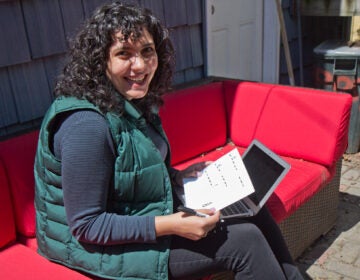
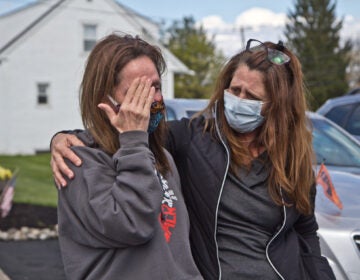
![CoronavirusPandemic_1024x512[1]](https://whyy.org/wp-content/uploads/2020/03/CoronavirusPandemic_1024x5121-300x150.jpg)


